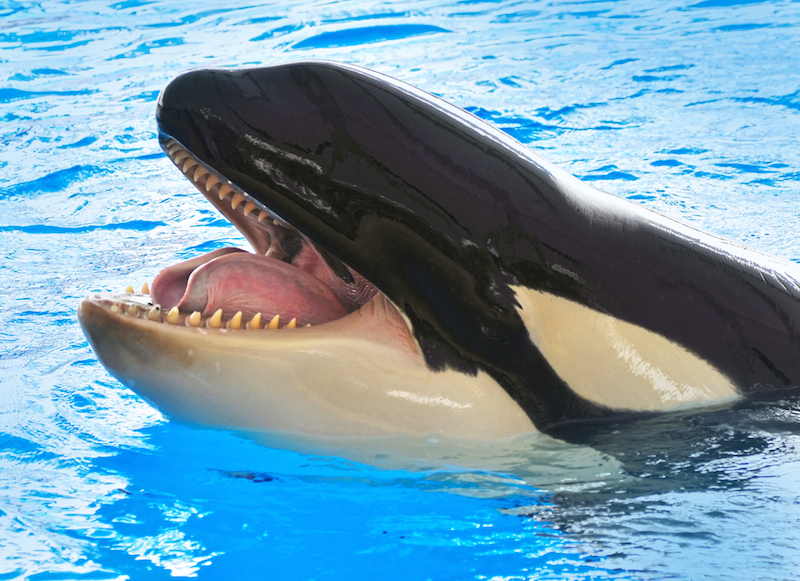Killer Whales Learn How to Speak Dolphin

Killer whales are known for their haunting songs consisting of complex whistles and clicks, but they can also learn "dolphin speak," a new study finds.
Most animals communicate with innate sounds, such as the barking of dogs and the gobbling of turkeys. But some species, humans, for example, can imitate new sounds and learn how to use them correctly in social situations. This ability, called vocal learning, is one of the foundations of language.
Vocal learning is present in bats, some birds and cetaceans — a group that includes whales, dolphins and porpoises. Avian scientists have identified specific neural pathways that play a role in learning birdsong, but studying language-learning in large marine animals is more difficult, the researchers said. [Deep Divers: See Photos of Amazing Dolphins]
Now, researchers have evidence that killer whales (Orcinus orca) can learn vocalizations from other species. When killer whales were socialized with bottlenose dolphins at a water facility, they changed the types of sounds they made to resemble those of their social partners, the study found.
How killer whales talk
Killer whale vocalizations include clicks, whistles and pulsed calls that sound like short spurts of sound followed by silence. However, the duration, pitch and pulse pattern varies across pods, suggesting each whale group has a unique dialect.
"There's been an idea for a long time that killer whales learn their dialect, but it isn't enough to say they all have different dialects so therefore they learn," study researcher Ann Bowles, a senior research scientist at Hubbs-SeaWorld Research Institute in Carlsbad, California, said in a statement. "There needs to be some experimental proof so you can say how well they learn and what context promotes learning."
Sign up for the Live Science daily newsletter now
Get the world’s most fascinating discoveries delivered straight to your inbox.
The researchers found the perfect creature for the experiment. Bottlenose dolphins (Tursiops truncates) produce sounds that are similar to those of killer whales, but they make them in different proportions. For instance, dolphins make more clicks and whistles, whereas killer whales produce more pulsed calls.
"We had a perfect opportunity, because historically, some killer whales have been held with bottlenose dolphins," Bowles said. Killer whales are the largest members of the dolphin family.
She and her team collected sound recordings from three killer whales that had been housed with bottlenose dolphins for several years, and compared them with sounds collected from seven killer whales and control bottlenose dolphins, which had not commingled.
Essentially, the killer whales that interacted with the bottlenose dolphins had a higher proportion of clicks and whistles, and a lower proportion of pulsed calls than the control whales did.
Killer whales can also learn entirely new sounds, the researchers found. One killer whale living alongside dolphins learned how to make a chirp sequence that a human caretaker had taught the dolphins before the whale's arrival.
Whale-dolphin language
The killer whales' vocal learning abilities don't necessarily mean that cetaceans have language in the same way that humans do, the researchers said. But the whales' skills do indicate a high level of neural plasticity, meaning their brain circuits can change to incorporate new information.
"Killer whales seem to be really motivated to match the features of their social partners," Bowles said. Perhaps such vocal imitation helps social interactions among cetaceans, though the scientists aren't sure whether the behavior has any adaptive significance, Bowles added.
Studying the vocal patterns of cetaceans can help researchers learn more about these threatened species. As their habitat shrinks because of human activities, both killer whales and dolphins have to compete with fisheries for food, and can get entangled in fishing gear. They also face collisions with water vessels and can get sick from pollutants and oil spills.
These marine animals may have an advantage if social bonds are tied to learned vocalizations from other species, the researchers said. Such a bond could help the animals survive amid different territories and social groups, they said.
"It's important to understand how they acquire [their vocalization patterns], and lifelong, to what degree they can change it, because there are a number of different [cetacean] populations on the decline right now," Bowles said. "And where killer whales go, we can expect other small whale species to go."
The study was published online Oct. 7 in The Journal of the Acoustical Society of America.
Follow Laura Geggel on Twitter @LauraGeggel and Google+. Follow Live Science @livescience, Facebook & Google+. Original article on Live Science.

Laura is the archaeology and Life's Little Mysteries editor at Live Science. She also reports on general science, including paleontology. Her work has appeared in The New York Times, Scholastic, Popular Science and Spectrum, a site on autism research. She has won multiple awards from the Society of Professional Journalists and the Washington Newspaper Publishers Association for her reporting at a weekly newspaper near Seattle. Laura holds a bachelor's degree in English literature and psychology from Washington University in St. Louis and a master's degree in science writing from NYU.










